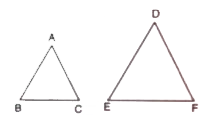At y = 1 cm, y = 3 cm y = 9 cm, y = 27 cm … and so on , an infinite number of charges equal to 5C are placed. At x = 1 cm, x = 2 cm, x = 4 cm, x = 8 cm …. And so on, an infinite number of charges equal to - 5C are placed. Find the electirc potential at origin is volts . (K=14πε0)
250 K
−250K
zero
100K
The correct Answer is:B
Step by step video & image solution for At y = 1 cm, y = 3 cm y = 9 cm, y = 27 cm … and so on , an infinite number of charges equal to 5C are placed. At x = 1 cm, x = 2 cm, x = 4 cm, x = 8 cm …. And so on, an infinite number of charges equal to - 5C are placed. Find the electirc potential at origin is volts . (K = (1)/(4pi epsilon_(0))) by Physics experts to help you in doubts & scoring excellent marks in Class 12 exams.
Updated on:21/07/2023Topper's Solved these Questions
- APPENDICES ( REVISION EXERCISE )BOOK - AAKASH SERIESCHAPTER - APPENDICES ( REVISION EXERCISE )EXERCISE - REVISION EXERCISE (CUTTENT ELECTRICITY )
108 Videos
- APPENDICES ( REVISION EXERCISE )BOOK - AAKASH SERIESCHAPTER - APPENDICES ( REVISION EXERCISE )EXERCISE - REVISION EXERCISE (MOVING CHANGES & MEGNETISM)
95 Videos
- APPENDICES ( REVISION EXERCISE )BOOK - AAKASH SERIESCHAPTER - APPENDICES ( REVISION EXERCISE )EXERCISE - REVISION EXERCISE (MAGNETISM AND MATTER )
52 Videos
- ALTERNATING CURRENTBOOK - AAKASH SERIESCHAPTER - ALTERNATING CURRENTEXERCISE - EXERCISE - III
24 Videos
- APPENDICES (REVISION EXERCISE)BOOK - AAKASH SERIESCHAPTER - APPENDICES (REVISION EXERCISE)EXERCISE - LAW OF MOTION
128 Videos
Similar Questions
An infinite number of electric charges each equal to 5 nano coulombs are placed along x-axis at x = 1 cm, x-2 cm, x -4 cm, x = 8 cm,.. and so on. In this setup, if the consecutive charges have opposite sign, then the electric field in newton/coulomb at x =0 is
View SolutionEqual charges each of 20μC are placed at x=0,2,4,8,16cm on X-axis. Find the force experienced by the charge at x=2cm.
View SolutionFind the area of a quadrilateral ABCD in which AB=3 cm, BC=4 cm, CD=4 cm, DA=5 cm and AC=5 cm
View SolutionFind the volume of a liquid present in a dish of dimensions 10 cm x 10 cm x 5 cm.
View Solution∆ABC ~ ∆DEF. If AB = 4 cm, BC = 3.5 cm, CA = 2.5 cm and DF = 7.5 cm, find the perimeter of ∆DEF
View SolutionThe perimeter of a parallelogram ABCD = 40 cm , AB = 3x cm, BC = 2x cm and CD = 2( y+1) cm . Find the values of x and y.
View SolutionIf A =12.0 cm ± 0.1 cm and B 8.5 cm ±0.5 cm, find A + B
View SolutionIn the figure, given below, AB, CD and EF are parallel lines. Given AB = 7.5 cm, DC = y cm, EF = 4.5 cm, BC = x cm and CE = 3 cm, calculate the values of x and y.

View SolutionIn the given figure, ΔABC is similar to ΔDEF,AB=(x−0.5) cm, AC=1.5xcm,DE=9cm,andDF=3xcm. Find the lengths of AB and DF.

View SolutionFind the surface area of the sphere whose radius is :
(a) 7 cm
(b) 3.5 cm
(c ) 1 cm
View Solution
